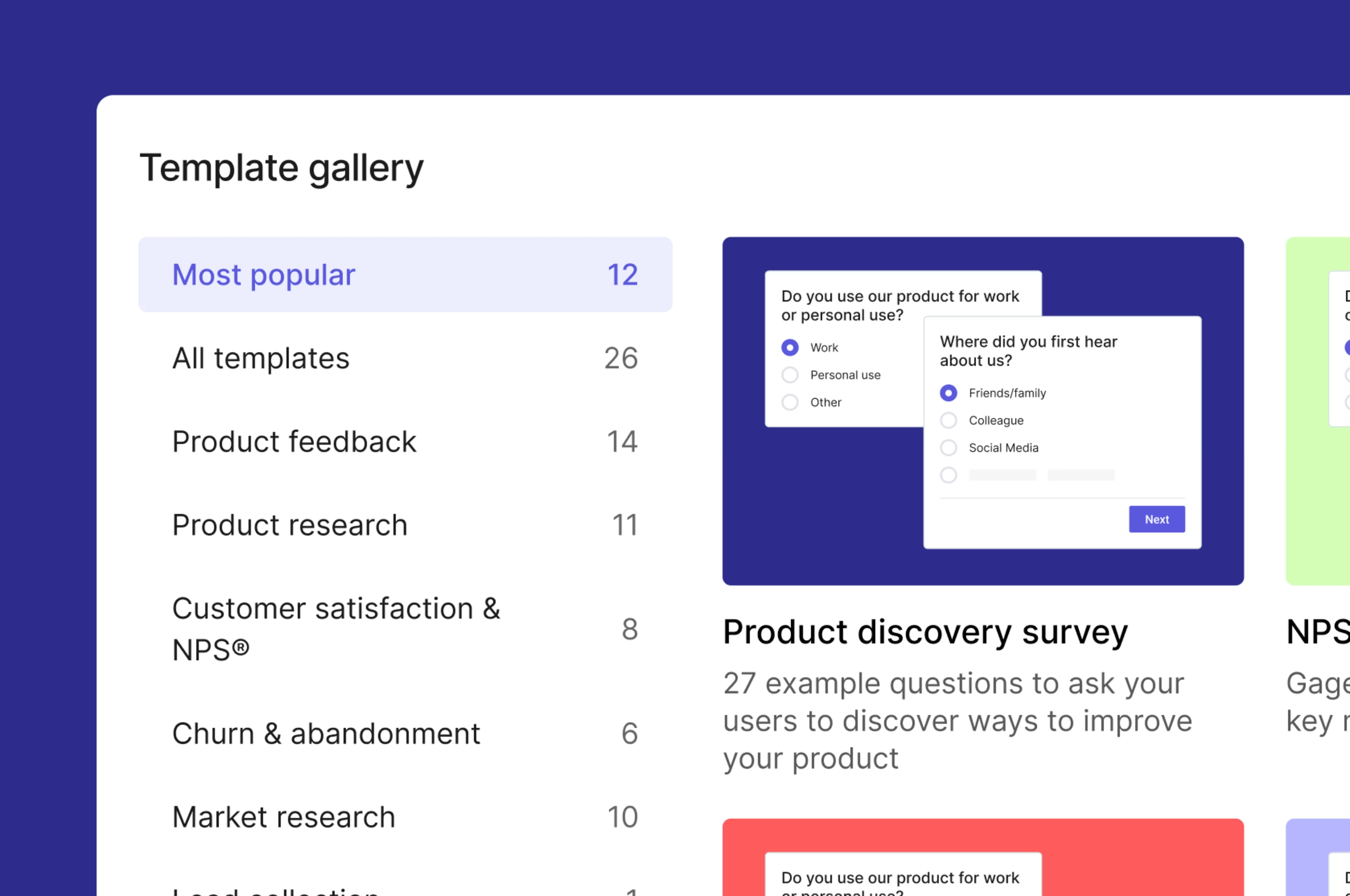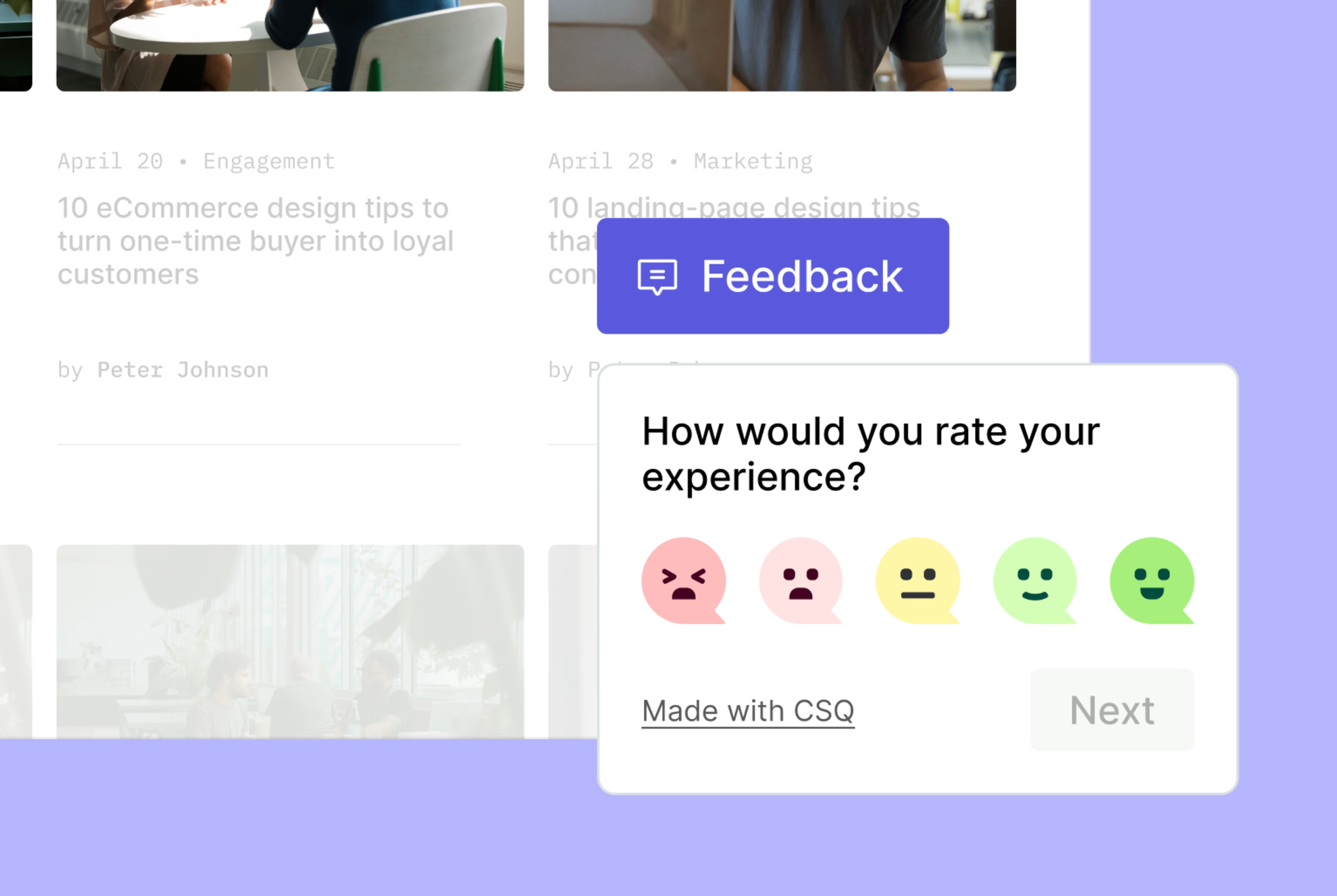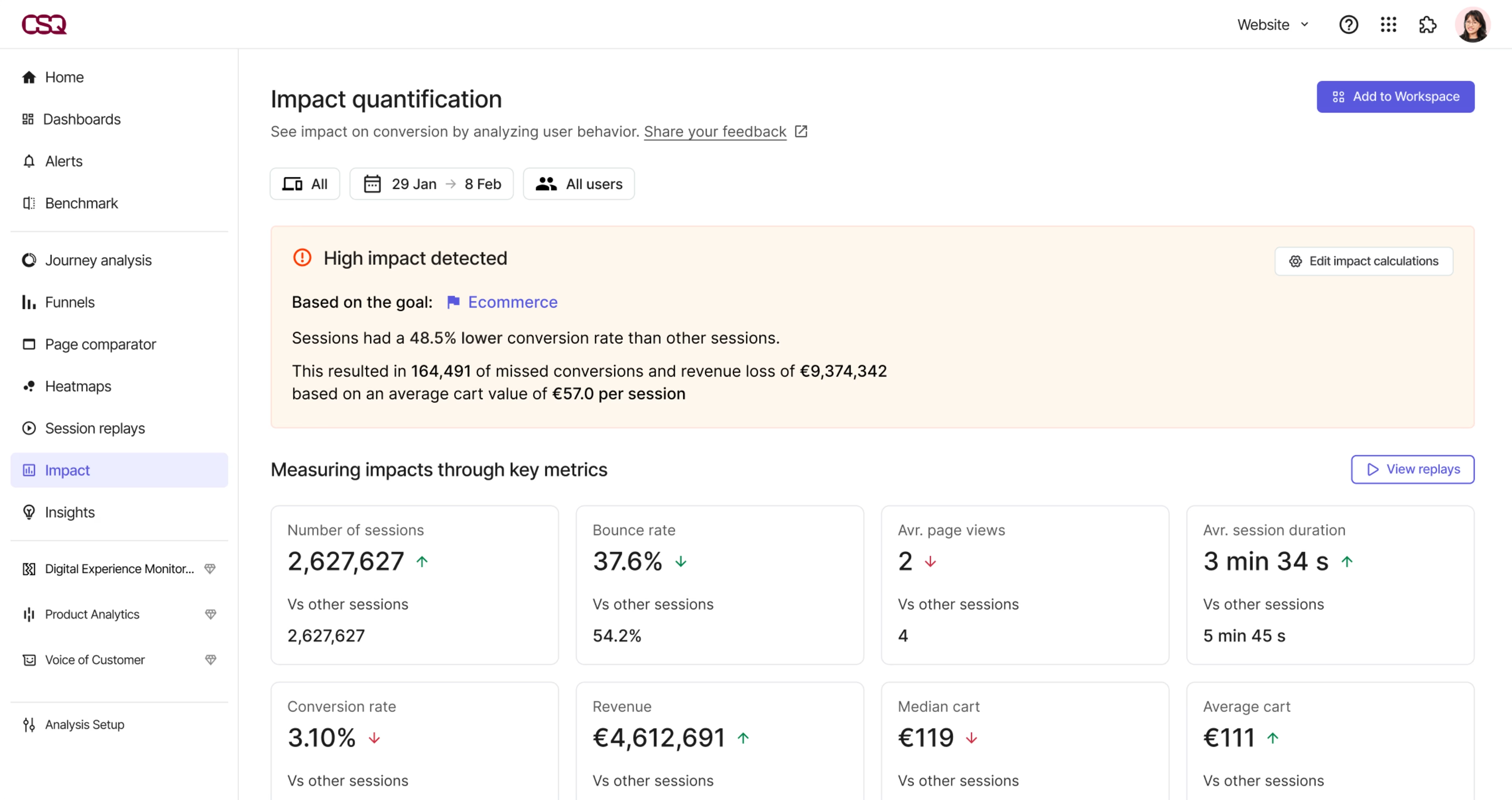Customer experience (CX) is the sum of every interaction a customer has with your brand, and is an important indicator of how likely they are to return or recommend you to others.
This guide shows you how to measure, evaluate, and improve different CX metrics.
Summary
Customer experience metrics measure how easy, enjoyable, and useful customers find their experience with your business across the entire customer journey. Kick off a successful CX program by tracking these seven key customer experience metrics:
Customer satisfaction score (CSAT): measures user satisfaction with a product, website, or service by letting users rate their overall satisfaction on a scale of 1-5
Customer effort score (CES): measures the amount of effort a customer has to exert to perform an action, rated on a scale from very difficult to very easy
Net Promoter Score® (NPS®): measures customer loyalty and satisfaction by asking customers how likely they are to recommend your product or service to others on a scale of 0 to 10
Customer churn and retention rate: measures the percentage of customers who stop subscribing to or buying products from a company, while retention measures a business’s ability to keep its customers over time
First response time (FRT): measures the average time it takes customer support teams to respond to support tickets, customer issues, or requests
Average resolution time (ART): measures the average time it takes a customer success team to successfully resolve each customer support request
Customer lifetime value (CLV or LTV): a revenue metric popular with CX teams that measures the average revenue a customer is expected to bring to your company over time.
The top 7 customer experience metrics used by experts
1. Customer satisfaction score (CSAT)
Customer satisfaction score is a simple measure of user satisfaction with a product, website, or service. A standard CSAT survey asks, “How satisfied were you with [product/website] today?” on a scale of 1 to 5, where 1 is very unsatisfied and 5 is very satisfied.
Measure CSAT by asking customers how satisfied they are at a relevant part of the customer journey, for example on a purchase confirmation page or when a user is logging out.
How to calculate CSAT
Add up the number of 4 and 5 ratings, divide by the number of responses, and multiply by 100.
👉 Set up a CSAT survey in moments with the survey templates in Voice of Customer

🔥 If you’re using Contentsquare: add a survey to any website page, and trigger CSAT follow-up questions if customers leave low ratings to find out why they aren’t satisfied. Not sure what to ask? Let our AI assistant generate questions for you. You can also collect CSAT responses from customers at any point in the user journey with our Feedback widget.
![[Visual] Feedback collection](http://images.ctfassets.net/gwbpo1m641r7/1GFuI7v7N2gDAzkD56MY4v/9180d9f08dbbca22c8342f6ac7ae6f23/Screenshot_2024-11-04_at_19.28.40.png?w=3840&q=100&fit=fill&fm=avif)
2. Customer effort score (CES)
Customer effort score measures the amount of effort a customer has to exert to perform an action (e.g. purchase a product, find information, or resolve a problem). CES is usually rated on a scale of 1 to 5 or 7, from very difficult to very easy.
Measure CES by asking customers, “How easy was it for you to [insert action here]?” when they complete a key action, for example:
After making a purchase
After using a service
After talking to customer support
You want CES to be as high as possible—a low customer effort score means customers find your website difficult to use or customer support unhelpful. Asking a follow-up question on low CES ratings will help you find out what’s holding customers back and adding friction to their journey.
How to calculate CES
Add all customer effort ratings and divide them by the total number of survey responses to get your average CES.
👉 Set up a CES survey in moments with the survey templates in Voice of Customer
🔥 If you’re using Contentsquare: use Session Replays to see how customers navigate your site. Look for rage clicks (rapid, frustration-induced clicks or taps on certain elements), as these customers might be putting in a lot of unnecessary effort to get something done.
![[Visual] Session replay - Triggered recording](http://images.ctfassets.net/gwbpo1m641r7/3x0k1KqlgQqa818JvI8mni/d323e94e4fcf5afeb2fd870577f06d15/Triggered_recording.png?w=3840&q=100&fit=fill&fm=avif)
3. Net Promoter Score® (NPS®)
Net Promoter Score is a customer loyalty and satisfaction metric obtained by asking customers how likely they are to recommend your product or service to others on a scale of 0 to 10.
Collect NPS responses by asking the standard NPS question (“On a scale of 0–10, how likely are you to recommend us?”) after a customer has received delivery of a purchase or used a service for a reasonable amount of time.

How to calculate NPS
Categorize responses into detractors (0 to 6), passives (7 and 8), and promoters (9 and 10), and subtract the percentage of detractors from the percentage of promoters. Or, take a shortcut with Hotjar by Contentsquare’s free NPS calculator.
👉 Use Contentsquare’s NPS Surveys to determine your NPS.
💡 Pro tip: NPS is a useful (and popular) benchmark to help alert you to customer experience problems, but without follow-up questions, you won't be able to fix them.
Ask these follow-up survey questions to find out more:
For those who score you 9 and 10 (i.e. your promoters) ask: “We’re thrilled you feel that way. What’s the main reason for your score?”
For those who score you 6 or less (i.e. your detractors) ask: “What can we do to improve your experience and your score?”
Ask everyone: “If we could do anything, what could we do to WOW you?”
🔥 If you’re using Contentsquare: use our Slack integration and send these responses to a dedicated channel so team members can stay on top of customer sentiment. The responses to these follow-up questions can help you plan your roadmap and make improvements to your product.
4. Customer churn and customer retention rate
Customer churn rate measures the percentage of customers who stop subscribing to or buying products from a company. On the flip side, customer retention is a business’s ability to keep its customers over time. And high churn and low retention rates indicate that something might be wrong with the customer experience, prompting customers to leave.
How to calculate customer churn and retention
For SaaS and subscription businesses: calculate monthly retention by dividing the number of active customers at the end of the month by the number of active customers at the beginning of the month. Your monthly churn is then the inverse of your monthly retention.
For ecommerce businesses: calculate retention by using cohort analysis to group customers who made repeat purchases in a chosen time frame.
👉 Set up your own B2B churn survey in moments with the survey templates in Voice of Customer
🔥 If you’re using Contentsquare: use Product Analytics to find what turns users into loyal customers and where potential buyers drop off.
Then, use our Impact Quantification tool to tie issues back to conversion rates so you can prioritize changes that will have the biggest impact on retention.

5. First response time (FRT)
First response time is a customer service metric that measures the average time it takes customer support teams to respond to a customer issue or request. FRT can be measured in days or hours, depending on your business.
How to calculate FRT
Add up all first response times and divide the result by the number of customer issues received.
Hiring more customer support staff will likely shorten first response times, but another way to achieve the same outcome is to optimize your website or product to reduce the number of support requests you receive.
6. Average resolution time (ART)
Average resolution time is the average time it takes a customer success team to successfully resolve each customer support request. Like FRT, ART can be measured in days or hours.
How to calculate ART
Add up the total duration of all customer conversations and divide the result by the number of customer chats or tickets.
Generally, the quicker the ART, the more likely a customer is to be satisfied and have enjoyed a positive experience with your service or product.
7. Customer lifetime value (CLV)
Customer lifetime value is the average revenue a customer is expected to bring to your company over time.
How to calculate CLV
For SaaS companies: CLV is measured by dividing monthly recurring revenue (MRR) by the total number of customer accounts, then dividing the result by user churn rate
For ecommerce: CLV is calculated by multiplying the average order value (AOV) by purchase frequency and estimated customer lifespan
CLV might first and foremost be considered a revenue metric, but it also represents customer loyalty and satisfaction. The happier your customers are, the more likely they are to buy from you again or stay subscribed. The result? Increased CLV and business revenue.
🔥 If you’re using Contentsquare: use Product Analytics to measure and analyze customer interactions across all touchpoints and campaigns to see how you can increase CLV.
Start tracking better CX metrics
Tracking, evaluating, and improving customer experience metrics is essential if you want more satisfied customers.
Want to know how customers really feel about their experience with your brand? Try Contentsquare and start collecting actionable insight, today!

![[Visual] Contentsquare's Content Team](http://images.ctfassets.net/gwbpo1m641r7/3IVEUbRzFIoC9mf5EJ2qHY/f25ccd2131dfd63f5c63b5b92cc4ba20/Copy_of_Copy_of_BLOG-icp-8117438.jpeg?w=1920&q=100&fit=fill&fm=avif)